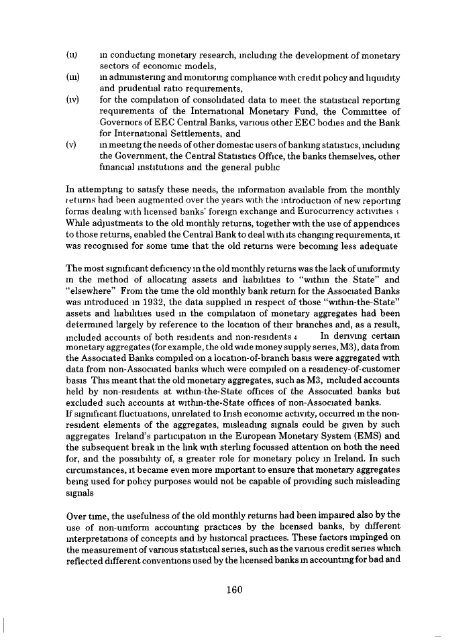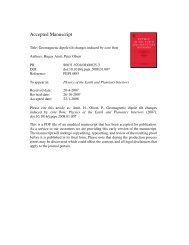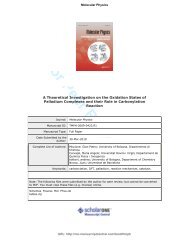parti: objectives and features of the new reporting system 159 - TARA
parti: objectives and features of the new reporting system 159 - TARA
parti: objectives and features of the new reporting system 159 - TARA
You also want an ePaper? Increase the reach of your titles
YUMPU automatically turns print PDFs into web optimized ePapers that Google loves.
(nj<br />
(in)<br />
(IV)<br />
(v)<br />
in conducting monetary research, including <strong>the</strong> development <strong>of</strong> monetary<br />
sectors <strong>of</strong> economic models,<br />
in administering <strong>and</strong> monitoring compliance with credit policy <strong>and</strong> liquidity<br />
<strong>and</strong> prudential ratio requirements,<br />
for <strong>the</strong> compilation <strong>of</strong> consolidated data to meet <strong>the</strong> statistical <strong>reporting</strong><br />
requirements <strong>of</strong> <strong>the</strong> International Monetary Fund, <strong>the</strong> Committee <strong>of</strong><br />
Governors <strong>of</strong> EEC Central Banks, various o<strong>the</strong>r EEC bodies <strong>and</strong> <strong>the</strong> Bank<br />
for International Settlements, <strong>and</strong><br />
in meeting <strong>the</strong> needs <strong>of</strong> o<strong>the</strong>r domestic users <strong>of</strong> banking statistics, including<br />
<strong>the</strong> Government, <strong>the</strong> Central Statistics Office, <strong>the</strong> banks <strong>the</strong>mselves, o<strong>the</strong>r<br />
financial institutions <strong>and</strong> <strong>the</strong> general public<br />
In attempting to satisfy <strong>the</strong>se needs, <strong>the</strong> information available from <strong>the</strong> monthly<br />
returns had been augmented over <strong>the</strong> years with <strong>the</strong> introduction <strong>of</strong> <strong>new</strong> <strong>reporting</strong><br />
forms dealing with licensed banks' foreign exchange <strong>and</strong> Eurocurrency activities i<br />
While adjustments to <strong>the</strong> old monthly returns, toge<strong>the</strong>r with <strong>the</strong> use <strong>of</strong> appendices<br />
to those returns, enabled <strong>the</strong> Central Bank to deal with its changing requirements, it<br />
was recognised for some time that <strong>the</strong> old returns were becoming less adequate<br />
The most significant deficiency in <strong>the</strong> old monthly returns was <strong>the</strong> lack <strong>of</strong> uniformity<br />
m <strong>the</strong> method <strong>of</strong> allocating assets <strong>and</strong> liabilities to "within <strong>the</strong> State" <strong>and</strong><br />
"elsewhere" From <strong>the</strong> time <strong>the</strong> old monthly bank return for <strong>the</strong> Associated Banks<br />
was introduced in 1932, <strong>the</strong> data supplied in respect <strong>of</strong> those "within-<strong>the</strong>-State"<br />
assets <strong>and</strong> liabilities used in <strong>the</strong> compilation <strong>of</strong> monetary aggregates had been<br />
determined largely by reference to <strong>the</strong> location <strong>of</strong> <strong>the</strong>ir branches <strong>and</strong>, as a result,<br />
included accounts <strong>of</strong> both residents <strong>and</strong> non-residents 4 In deriving certain<br />
monetary aggregates (for example, <strong>the</strong> old wide money supply series, M3), data from<br />
<strong>the</strong> Associated Banks compiled on a location-<strong>of</strong>-branch basis were aggregated with<br />
data from non-Associated banks which were compiled on a residency-<strong>of</strong>-customer<br />
basis This meant that <strong>the</strong> old monetary aggregates, such as M3, included accounts<br />
held by non-residents at within-<strong>the</strong>-State <strong>of</strong>fices <strong>of</strong> <strong>the</strong> Associated banks but<br />
excluded such accounts at within-<strong>the</strong>-State <strong>of</strong>fices <strong>of</strong> non-Associated banks.<br />
If significant fluctuations, unrelated to Irish economic activity, occurred in <strong>the</strong> nonresident<br />
elements <strong>of</strong> <strong>the</strong> aggregates, misleading signals could be given by such<br />
aggregates Irel<strong>and</strong>'s <strong>parti</strong>cipation in <strong>the</strong> European Monetary System (EMS) <strong>and</strong><br />
<strong>the</strong> subsequent break in <strong>the</strong> link with sterling focussed attention on both <strong>the</strong> need<br />
for, <strong>and</strong> <strong>the</strong> possibility <strong>of</strong>, a greater role for monetary policy in Irel<strong>and</strong>. In such<br />
circumstances, it became even more important to ensure that monetary aggregates<br />
being used for policy purposes would not be capable <strong>of</strong> providing such misleading<br />
signals<br />
Over time, <strong>the</strong> usefulness <strong>of</strong> <strong>the</strong> old monthly returns had been impaired also by <strong>the</strong><br />
use <strong>of</strong> non-uniform accounting practices by <strong>the</strong> licensed banks, by different<br />
interpretations <strong>of</strong> concepts <strong>and</strong> by historical practices. These factors impinged on<br />
<strong>the</strong> measurement <strong>of</strong> various statistical series, such as <strong>the</strong> various credit series which<br />
reflected different conventions used by <strong>the</strong> licensed banks in accounting for bad <strong>and</strong><br />
160
















